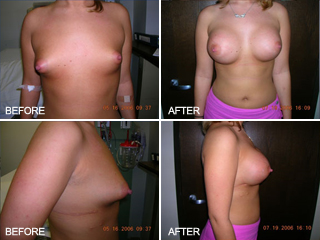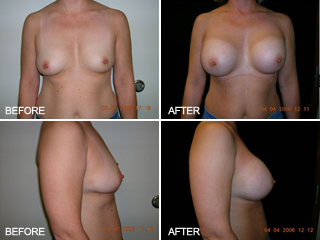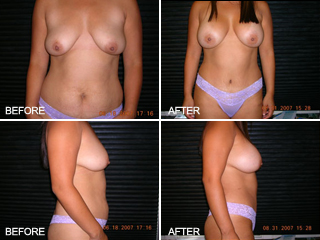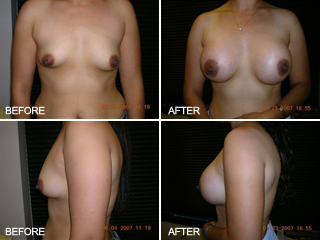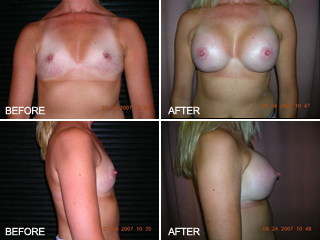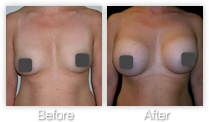About Breast Augmentation Surgery
What is Breast Augmentation?
Breast augmentation or Augmentation Mammoplasty is a surgical procedure that enhances women’s breast size and/or shape by surgically inserting an implant filled with saline behind the natural breast. Breast Augmentation is a desirable option among women seeking the following:
- to correct a reduction in volume due to a pregnancy
- to correct a size difference
- to enhance contour for a women who is unhappy with the size or shape
- as a reconstruction following breast surgery
Breast augmentation can enhance one’s self confidence and image but will not necessarily change your appearance to match your ideal. It is important to keep this in mind before deciding to have breast augmentation surgery. A realistic and informed approach will yield the best and expected results.
Those Ineligible for Breast Augmentation
If you are pregnant or nursing, have a malignant or pre-malignant cancer in breast(s) or have an active infection anywhere within the body, breast augmentation surgery is not an option. There are too many risks associated with each to be considered safe.
How is Breast Augmentation Performed?
There are four methods used widely by surgeons performing breast augmentation surgery. The differences in each method exist in the location the implant is inserted from and the location the implant is placed. Discuss with your doctor which method is best for you. The different names of the methods described below refer to the location of the incision and point of entry of the breast implant.
Transaxillary: By placing the incision in the skin folds of the armpit this breast augmentation entry point leaves little to no scarring even when the arms are held above the head.
Periareolar: This breast augmentation surgery is performed through the areola making the incision where the darker pigmented skin of the areola meets the lighter skin of the breast.
Inframammary: In this method the doctor places the incision under the breast on the crease, making re-augmentation or revisions easier. One disadvantage to this method is that the scarring may be visible to some extent when holding your arms over your head. If you are opposed to a slightly visible scar then you may want to consider one of the other 3 options.
Transumbilical: This popular approach to breast augmentation surgery allows both implants to be placed with the assistance of an endoscope through a single incision in the upper fold of the belly button, leaving no visible scarring. It has gained in popularity but remains a fairly new method of breast augmentation.
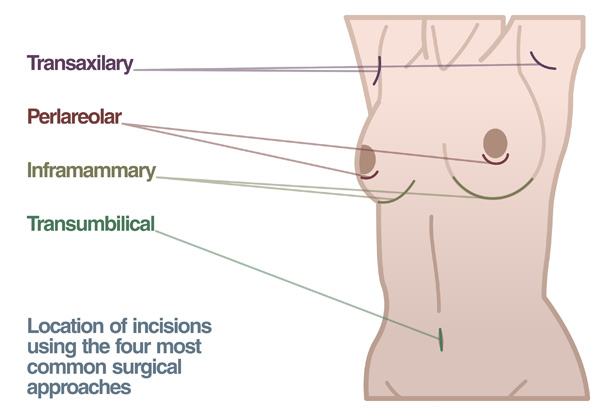
Advantages and Disadvantages:
The main advantages and disadvantages can be outlined by noting that the two methods producing slightly visible scarring have the quickest recovery time, and the other two, producing very slight if any visible scarring will have a longer recovery time. Consult with your physician on the best augmentation procedure for you.
Placement of the Breast Implant
The placement of a breast implant for breast augmentation surgery will depend on the amount of existing breast tissue and your desired outcome. These details should be discussed with your doctor and vary among patients. Each placement location produces a slightly different result. The 3 possible locations of placement are as follows:
Subfacial: Between the muscle and covering fascia
Suglandular: Above the pectoral muscle
Subpectoral: Below the pectoral muscle

In addition to placement options of the implant for Breast Augmentation Surgery, one can choose from the shape and size of the implant.

How to Prepare for your Surgery
The following are some guidelines to follow in preparation for your Breast Augmentation. Each individual is different or may have varied circumstances. Your doctor will give you more detailed information when you schedule your surgery.
- It is important for proper healing of the incision, and to prevent noticeable scarring to refrain from smoking before and after the surgery.
- No food or drink including water after midnight the night before your surgery
- Eat healthy in the days leading up to the surgery and avoid alcohol at least 3 days prior to your procedure.
- No aspirin or ibuprofen for 2 week prior as excessive bleeding and post operative complications can result. If you are taking any other prescription medication, make sure your physician is aware before the surgery.
- You may brush your teeth the morning of your surgery. Any medication taken the morning before (as prescribed by your doctor) should be taken with one sip of water.
- Showering and washing the surgical areas with antimicrobial soap the night before and the morning of your surgery is a good idea. Remove nail polish and avoid hair sprays, makeup, moisturizers, oils or cream, and deodorant the day of your surgery
- Extremely vigorous exercise should be avoided the day before your surgery.
- Wear loose fitting clothes that open in the front and flat, slip on shoes.
- Arrange for an adult to be with you for the first 24 hours after your procedure. Preparing food and fluids before your surgery is recommended and it is also a good idea to make arrangements for the care of small children if you have them.
- Any other responsibilities or medications needed should be handled prior so that your schedule is clear and you may have a worry free, relaxing day following the surgery.
What to Expect After Breast Augmentation Surgery
Activity: You will want to rest after your breast augmentation surgery from the general anesthesia and should wait 24 hours before driving a car, until it has fully worn off. Avoid strenuous activity for at least three weeks and always wear a sports bra when active.
Showering and Bathing: Immediately following your breast augmentation surgery, you will be instructed when to remove the wraps and when showering is okay by either your doctor or the recovery room staff.
Position: Propping yourself up with pillows is always a good idea to reduce swelling. Any comfortable position when sleeping is okay.
Post-Operative Visits: You will come in 1 to 4 days following your augmentation procedure. Depending on the placement of the implant you may receive a breast stabilizer, during which time will also be given post operative instructions on care. Any steristrips or tape on your incisions should be left alone until your doctor instructs you to remove them.
Dressings: The bra and ace wrap will prevent initial bleeding and should be left on until instructed to remove from your doctor. Week one you are instructed to wear a bra at all times. Week two you can remove the bra at night when sleeping. No underwire bra’s for three months following your breast augmentation.
Vitamins: Take vitamin E (400 units) twice a day for 6-8 weeks, starting after 7 days.
Deodorant: Patients who received the Transaxilary procedure for breast augmentation (under the skin folds of the armpit) should not wear deodorant for 1 week following their surgery to avoid infection.
Exposure to Sunlight: For up to a year following your surgery you should protect the scarred areas from any sunlight even if covered by a bathing suit. No tanning breasts, nude, for 1 year and no tanning or sunbathing for two weeks following breast augmentation surgery.
Lifting: No lifting anything over 5 pounds for the first week. 10 pounds the second week and 15 pounds the third week.
Post Operative Healing: What is normal?
People in general can vary on how quickly they heal and the types of normal occurrences they have while healing. Some of these normal processes listed below may or may not pertain to how you heal after your breast augmentation surgery, but it is important not to be alarmed if they do occur.
- Asymmetry: Two breasts may not heal at the same pace, or one may swell more than the other appearing different in size or shape. After the proper healing has occurred they should look equal to the other and natural.
- Shiny Skin: The skin covering the breasts may become shiny as a result of swelling after your breast augmentation surgery. Within a few weeks when the swelling subsides the skin will go back to normal.
- “Sloshing” Sensation: Natural fluid and air may accumulate in the space surrounding the implant. You may hear and feel “sloshing” however your body will absorb it within a few weeks.
- Sensitivity: During nerve regeneration the nipples can become hypersensitive. Gentle massaging helps, though this will eventually go away not long after your breast augmentation surgery.
- Sensory Nerves: You may feel shooting pains, tingling or burning after your surgery, which will disappear with time. These feelings are perfectly normal and are an indication of the healing process in action.
Risks and Complications of Breast Augmentation Surgery
Though happening infrequently the most common complication resulting from Breast Augmentation Surgery is called capsular contracture. Due to placement of a foreign object under the skin, scar tissue forms and can tighten and squeeze the breast implant forming a hard shell. When caught in the early stages it can be corrected by your doctor with a non invasive procedure of simply squeezing the breast tissue. If it worsens, a surgical procedure to remove and possibly replace the encapsulated implant is necessary.
This page is intended only to inform patients about the breast augmentation procedure, and cannot answer all breast augmentation questions since much depends on the patient's individual circumstances. Ask the surgeon at your initial consultation or preoperative visit if there is anything you do not understand about the breast augmentation procedure or feel free to use our contact form to submit any questions to our staff.
